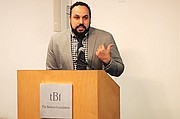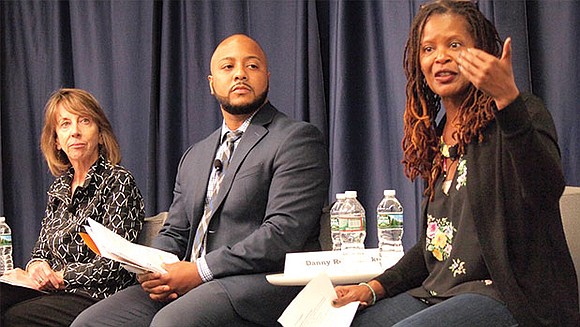By Jule Pattison-Gordon
The Bay State Banner, October 26, 2017 —
Too few nonprofit organizations in the U.S. — including those serving communities of color — are led by people of color, and more than one-third of people of color in the nonprofit sector report that their race appears to negatively impact their career advancement, according to a new report by the Building Movement Project. Less than 20 percent of nonprofit CEOs or executive directors are people of color — a figure that has stayed static for more than a decade, according to the report.

Sean Thomas- Breitfeld, co-director of The Building Movement Project and co-author of its report “Race to Lead.” Banner photo
During a discussion at The Boston Foundation last week, report co-author Sean Thomas-Breitfeld said that while there are numerous people of color in senior management second-tier leadership positions, there appears to be a barrier to top-level roles such as executive director or board chair. Beyond moral reasons, taking steps to advance diversity, equity and inclusion are critical to effective work, said various speakers at the event.
“It is not a ‘nice to do,’ it is a ‘must do,’” said Orlando Watkins, The Boston Foundation’s vice president for programs.
Myths and obstacles
There is a prevailing myth that the absence of people of color among leadership roles was due to a weaker interest in leading, a need for skills training and a tendency for qualified leaders of color to leave the sector, stated Thomas-Breitfeld and Francis Kunreuther, Building Movement Project co-directors and co-authors of the report.
However, when they surveyed thousands of people from the nonprofit sector, the researchers found that respondents of color were more likely than white respondents to aspire to leadership. People of color and whites reported similar experience, skills and educational backgrounds, although some people of color said they felt that official documentation of their skills, such as certificates, was more important for them as their qualifications would be scrutinized more harshly than those of similarly-skilled white candidates.
Obstacles stemmed from biased systems, with many minorities passed over in hiring due to assessments that they were not a good “culture fit” — essentially being filtered out due to unconscious bias. Many reported that recruiters for top-level nonprofit positions did a poor job of finding and presenting numerous candidates of color. Respondents of colors also reported a lack of mentors, a perceived lack of human resources support and stress from being asked to represent their entire race to white colleagues. In a write-in response, one person said their organization seemed to value only their racial identity, and to overlook their other abilities.
Even when people of color lead nonprofits, many perceive less access to funding sources, with some saying that connecting with traditional funders depends largely on access to funders’ social circles or similar enough backgrounds to make personal connections.

Nonprofit panelist spoke at The Boston Foundation. Left to right: Deborah Re, president and CEO of Big Sister Association of Greater Boston; Danny Rojas, director of postsecondary partnerships for OneGoal; and Trina Jackson, inclusion initiative program coordinator of the Third Sector New England – MIssion Works. BANNER PHOTO
“So much about fundraising is about personal connections and moving in particular circles and engaging with people in a particular way,” said panelist Trina Jackson, inclusion initiative program coordinator for TSNE MissionWorks (formerly Third Sector New England). “You’re talking to people, networking and interacting — having a conversation on where you went to school, where you go on vacation, what kind of food you eat. We know there is racial segregation across all of those areas. If that’s the main way we do fundraising, then people of color are absolutely facing a barrier.”
This creates additional burdens on minority-led organizations, as with less funding, they tend to be smaller and their executive directors need to take on extra work such as hosting events and writing grants in addition to running the organization, Jackson said.
Organizational need
Shaheer Mustafa, CEO of Hopewell (formerly Dare Family Services) has a staff that is 50 percent of color and a management team that is 80 percent of color. Achieving diversity relies on framing it as a business imperative, he said. For instance, organizations that cannot reach, recruit and retain people of color miss out on some of the top talent as well as the variety of perspectives that leads to creative problem solving.
“Values are not enough,” Mustafa said. “Those organization that are effective at diversity, inclusion and equity are those than can effectively articulate a business case.”
Several speakers also noted that any organization seeking to serve communities of color risks being tone deaf and less informed if it does not have people of color among the decision makers.
Real solutions
The report’s findings point to a need to shift solution strategies from training individual candidates of color to training existing leadership and providing new organization offerings.
These include helping board members to identify their own biases before making hiring decisions and extending mentorship supports to new leaders of color, report authors said.
One approach starts with awareness and open conversation. Deborah Re’s Big Sisters Association of Greater Boston primarily serves girls of color but several years ago found that only 20 percent of the big sister mentors and only 17 percent of the organization staff at the time were people of color. The nonprofit has jumped to 40 percent staff of color after an active examination of their hiring process and image. Methods included explicitly stating online that the organization seeks candidates of color; reassessing hiring questions to ensure they measure skills such as understanding of Boston history and cultural competency; creating a diversity council with community members; dropping a master’s in social work requirement that leaders determined to be unnecessary; and examining whether the organization creates an environment that would retain employees of color, for example considering what types of messages are sent by images present in the offices and by celebration of holidays like Columbus Day. Re said she seeks to create an environment where it is easy for people to speak out if they find something offensive and encourages regular conversations on experiences within the organization.
Jackson underscored the importance of ensuring that people of color in an organization have opportunities to actively engage and be included, not simply to be made a “diversity presence.” In addition, she said, the model of what leadership looks like needs to be expanded beyond the stereotype of a formally-educated, independently-acting white western male.
Danny Rojas, director of postsecondary partnerships for OneGoal, said his organization’s approach includes offering affinity groups — such as a men of color group or a Christian group — that regularly meet, as well as providing every new hire with a mentor to provide support throughout their career at OneGoal and fostering conversation about concerns and experiences of employees.
Report authors also made it clear that funders and associations that set standards have roles to play by focusing support on organizations advancing diversity and inclusion and by promoting such values.
The study
The report authors conducted about three dozen interviews with nonprofit leaders, capacity builders and funders in order to inform a subsequent online survey, which collected more than 4,300 responses nationwide from the nonprofit sector. The sector is largely female, and 78 percent of survey respondents identified as female, while 58 percent identified as white alone.
Local results
Of the 4,300 nationwide respondents, 176 were from Massachusetts, with 96 of them from Boston. Massachusetts respondents reported at a higher rate than the national group overall that determinations of “culture fit” removed candidates of color from hiring pools, and more people of color in Massachusetts reported being called upon to represent an entire community, according to Kunreuther. Though the sample size for an individual city may be too small to draw inferences, 85 percent of respondents of color from Boston said executive recruiters contributed to lack of diversity — a greater share than in the state as a whole. On the other hand, the share of people reporting that race was seen as an asset helping them advance was only 38 percent nationally, but 55 percent in Massachusetts and 60 percent in Boston, though others still said race was regarded as a barrier.









